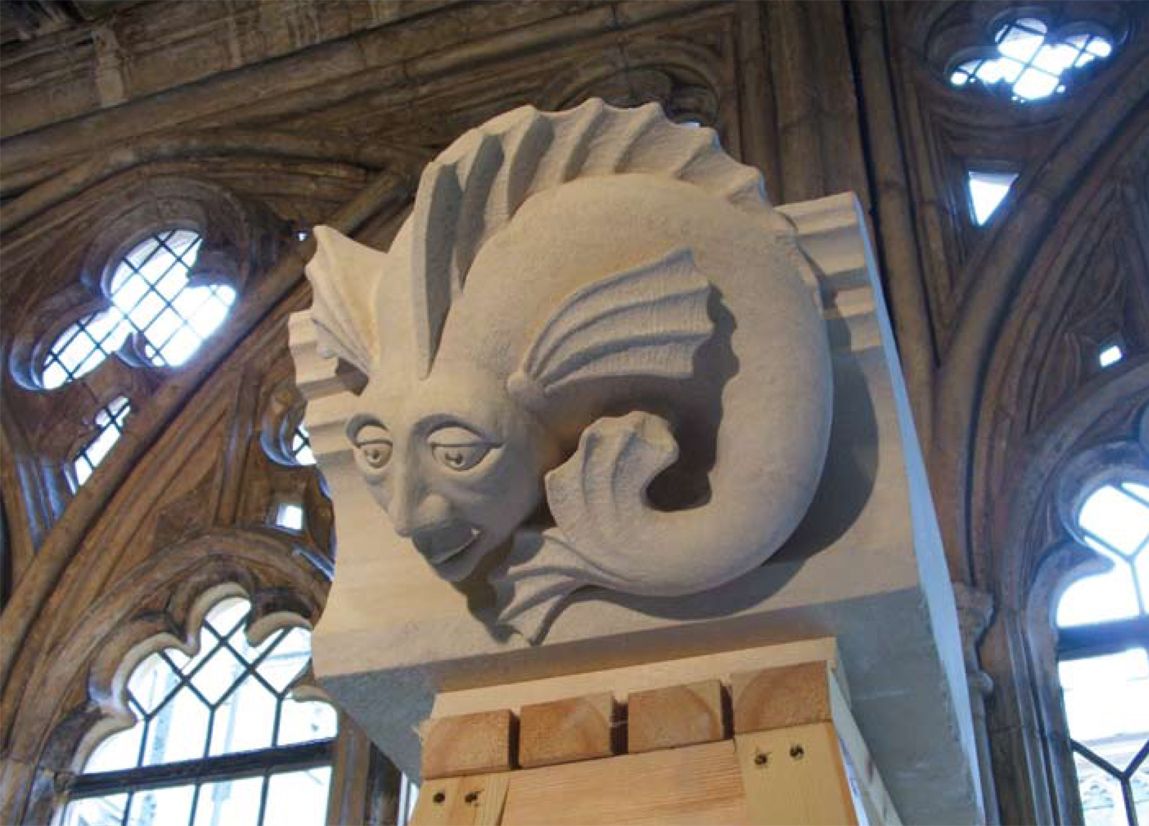St. George’s Chapel at Windsor has literally reinvented the medieval genre of grotesques
The College of St George has been working in partnership with the City and Guilds of London Art School in establishing an imaginative carving programme which is producing exciting new grotesque sculptures for St George’s Chapel.
The replacement sculptures aim to reproduce the scale and detail of the original mediaeval conception whilst allowing students the opportunity to be inventive in designing new carvings. The new grotesques replace heavily eroded Victorian grotesques which themselves replaced medieval carvings of unknown design.
In architecture the term “grotesque” means a carved stone figure. Grotesques are often confused with gargoyles, but the distinction is that gargoyles are figures that contain a water-spout through the mouth, while grotesques do not. This type of sculpture is also called a chimera. Grotesques and Gargoyles experienced their heyday in the Gothic period.

Students were encouraged and mentored throughout the process. Visits to the Chapel by City & Guilds students included a close up look at some of the 15th century wooden carvings in the Quire to help fire their imagination; visits to the City & Guilds by some of the Chapel team and the Sculpture Group of the Fabric Advisory Committee helped the dialogue remain fresh and exciting.
Among the really imaginative designs is a recreation of the famous ear-mouse from 1997, which had a human ear protruding from its back. Other designs are a fish with a human head, the earth mother and a the Hindu elephant god, Ganesha. Not all designs were accepted by the dean, though. For instance a pair of feet with sneakers was rejected. However, according to the Guardian the dean and canons feel elated by the charm of the new gargoyles laughing down from high up on the outer wall of the chapel. The new carvings are in a creamy Syreford stone from the Cotswold.
 The college and church of St George were founded by Edward III in 1348 at the same time as the Order of the Garter. However, the present chapel is a light-filled wonder of late Gothic architecture, which was commissioned by Edward IV in 1475, who was also buried there. Despite the fact that it is full of royal tombs including those of Henry VIII and Charles I the college of St. George is ain fact an independent institution. At its heart it is a community of people who live and work together to offer worship to God, prayers for the Sovereign and the Order of the Garter, service to the society and hospitality to visitors.
The college and church of St George were founded by Edward III in 1348 at the same time as the Order of the Garter. However, the present chapel is a light-filled wonder of late Gothic architecture, which was commissioned by Edward IV in 1475, who was also buried there. Despite the fact that it is full of royal tombs including those of Henry VIII and Charles I the college of St. George is ain fact an independent institution. At its heart it is a community of people who live and work together to offer worship to God, prayers for the Sovereign and the Order of the Garter, service to the society and hospitality to visitors.
SOURCE:
Imaginative Sculpture – Protecting the Sacred Space
VISIT:
The exhibition – Imaginative Sculpture: Protecting the Sacred Space – in the Dean’s Cloister (at the exit from St George’s Chapel) will normally be open Monday to Saturday 10am to 4pm until 18 December; Windsor Castle admission charges apply. At the centre of the exhibition are ten grotesque sculptures together with an explanation of the creative and selection process.
READ MORE:
 A catalogue, priced at £10, is available to purchase from the Chapel Shop in the Dean’s Cloister or from our website – click to purchase catalogue online. The catalogue feature photographs of all the new grotesques created as a result of the collaboration between the Dean & Canons of Windsor and the City & Guilds of London Art School.
A catalogue, priced at £10, is available to purchase from the Chapel Shop in the Dean’s Cloister or from our website – click to purchase catalogue online. The catalogue feature photographs of all the new grotesques created as a result of the collaboration between the Dean & Canons of Windsor and the City & Guilds of London Art School.
To find out more about the sculpting process you can watch the video below and visit the website of the City & Guilds of London Art School
SEE MORE:
Creating new grotesques for St George’s Chapel, Windsor Castle from St George’s on Vimeo.
